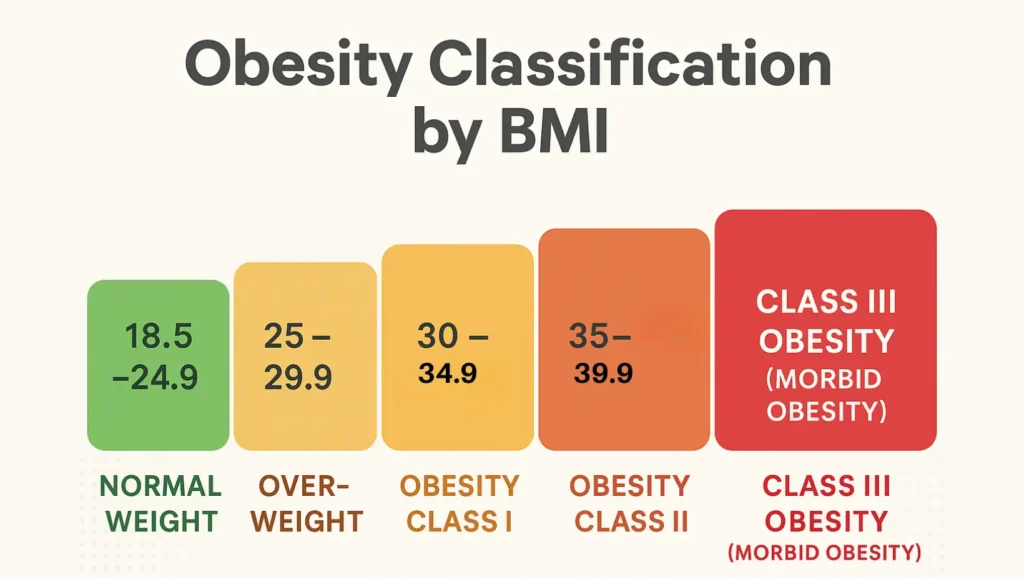Class III obesity is the medical term for the most severe form of obesity. Many people still know it as morbid obesity, but doctors now prefer the modern term because it reduces stigma and gives a clearer description. This condition is not just about weight. It is linked to serious health risks, reduced quality of life, and shorter life expectancy. Understanding obesity classification, causes, symptoms, and treatment options is the first step toward managing it.
Table of Contents
ToggleOverview
What Is Morbid Obesity (Now Known as Class III Obesity)?
Morbid obesity is the highest category in the obesity classification system. The cutoff is based on the body mass index (BMI) scale. A BMI of 40 or higher is usually called Class III obesity or morbid obesity. Sometimes, people with a BMI between 35 and 39.9 also fall into this group if they have major weight-related health problems like diabetes, heart disease, or sleep apnea.
This type of obesity used to be called “morbid” because it is strongly linked to life-threatening health conditions. The term “Class III obesity” is now more commonly used because it is less stigmatizing while still highlighting the seriousness.
What BMI Is Considered Morbid Obesity?

The question what BMI is morbid obesity can be answered simply:
- BMI 40 or higher is always Class III obesity.
- BMI 35 to 39.9 can also qualify if the person already has severe conditions such as Type 2 diabetes, high blood pressure (hypertension), or obstructive sleep apnea.
Here’s a quick breakdown of obesity levels according to the BMI scale:
| BMI Range | Category |
| 18.5 – 24.9 | Normal weight |
| 25 – 29.9 | Overweight |
| 30 – 34.9 | Obesity Class I |
| 35 – 39.9 | Obesity Class II |
| 40 and above | Class III obesity (Morbid obesity) |
Symptoms And Causes
What Are The Symptoms Of Class III Obesity?
Class III obesity itself is defined by BMI rather than visible symptoms. But it usually brings physical signs and health effects such as:
- Difficulty with mobility and daily activities
- Shortness of breath even with light activity
- Fatigue and low stamina
- Joint pain due to excess adipose tissue or body fat
- Excessive sweating
- Sleep problems, including sleep apnea
- Emotional struggles linked to depression or mental health conditions
What Are The Complications Of Class III Obesity?
Complications are what make Class III obesity dangerous. The risks extend to nearly every system of the body:
- Type 2 diabetes risk rises sharply.
- Cardiovascular disease and obesity are closely connected, leading to heart attack and stroke.
- High blood pressure or hypertension is common.
- Liver disease such as fatty liver and cirrhosis may develop.
- Kidney disease risk increases.
- Osteoarthritis worsens as extra weight damages joints.
- Sleep apnea (obstructive sleep apnea) interferes with breathing at night.
- Several forms of cancer (pancreatic, colorectal, breast, liver) occur more often in people with Class III obesity.
Mental health is also strongly affected. Many people experience low self-esteem, anxiety, and chronic depression.
What Causes Class III Obesity?
Causes of extreme obesity are complex. No single factor explains why someone develops severe obesity. Instead, it is a mix of biology, environment, and daily life.
What Are The Risk Factors For Class III Obesity?
- Genetics (obesity-related genes): Some people have inherited traits that make it easier to store fat.
- Genetic syndromes (Cohen, Down, Prader-Willi): Rare conditions where weight gain is part of the disorder.
- Hormonal conditions (Cushing, PCOS, hypothyroidism): Imbalances in hormones such as cortisol or thyroid hormones lead to weight gain.
- Lifestyle factors (diet, physical activity, sleep, stress): Poor diet, low activity, lack of sleep, and high stress contribute heavily.
- Environmental, cultural, financial or geographical factors: Access to fresh food, safe exercise spaces, and cultural eating habits all matter.
- High waist circumference often signals higher risk of metabolic syndrome, a cluster of high blood sugar, blood pressure, and cholesterol.
Diagnosis And Tests
How Is Class III Obesity Diagnosed?
Diagnosis begins with a BMI calculation. Doctors also measure waist size, check body fat levels, and ask about medical history. A physical exam helps spot linked problems.
What Tests Are Used To Diagnose Class III Obesity?
Doctors often order a set of lab and imaging tests, such as:
- HbA1C – checks long-term blood sugar control
- Lipid panel – measures cholesterol and triglycerides
- TSH – checks thyroid function
- CRP – shows body inflammation
- EKG – checks heart rhythm
- Sleep study – confirms obstructive sleep apnea
Obesity Classification By BMI
Doctors use the obesity classification chart to place patients into categories. While BMI is not perfect, it is still the easiest tool for public health and medical use. More advanced tools like DEXA scans and body fat percentage can add accuracy.
Management And Treatment
What Is The Treatment For Class III Obesity?
Treatment is personalized. There is no single cure, but there are effective strategies. The main goal is to lower health risks, improve life quality, and extend life expectancy. Obesity management combines medical support, therapy, and sometimes surgery.
Healthy Lifestyle Changes
Doctors often recommend gradual lifestyle changes for obesity:
- Adopting healthy eating such as the DASH plan or Mediterranean diet
- Increasing physical activity
- Improving sleep routines
- Practicing stress management techniques
Even a weight loss of 5–10% of body weight can improve blood pressure and blood sugar.
Behavioral Therapy And Psychotherapy
Since habits and emotions play a big role, therapy helps. Options include:
- Cognitive Behavioral Therapy (CBT): Restructures thoughts and habits
- Dialectical Behavior Therapy (DBT): Teaches coping strategies
- Interpersonal Therapy (IPT): Focuses on social and emotional health
These therapies support long-term behavior change.
Medications
Modern medicines are powerful tools for obesity management. Approved drugs include Orlistat, Phentermine, Topiramate, Naltrexone-Bupropion, Liraglutide, Semaglutide, and Tirzepatide. They reduce appetite or affect metabolism. Some produce average losses of 15–20% body weight, making them life-changing for many patients.
Weight Loss Procedures (Surgery & Non-Surgical Options)
When BMI is very high, surgical treatment for obesity may be the most effective choice. Options include:
- Bariatric surgery: Gastric bypass, sleeve gastrectomy, gastric band
- Endoscopic procedures: Endoscopic sleeve gastroplasty, intragastric balloon
Bariatric surgery can reduce excess weight by 30–77%. These results are often permanent if combined with lifestyle changes. Endoscopic procedures are less invasive but generally lead to smaller weight losses.
When Should I See My Healthcare Provider?
Anyone with a BMI above 35 and related health problems should see a provider. People with BMI over 40 should seek care even without symptoms. Early evaluation prevents worsening health.
What Questions Should I Ask My Doctor?
- Which treatments fit my case?
- What risks do I face if I don’t treat Class III obesity?
- What are the side effects of medicines or surgery?
- How much weight can I expect to lose?
- What support systems are available?
Outlook / Prognosis
What Is The Prognosis For Class III Obesity?
Without treatment, Class III obesity shortens life and increases disease risk. But with proper care, outcomes can improve. Lifestyle changes, therapy, medicines, and surgery together reduce risk of cardiovascular disease, Type 2 diabetes, and cancer.
What Is The Life Expectancy Of Someone With Class III Obesity?
Studies show people with Class III obesity live 6–14 years less than average. The higher the BMI, the shorter the life expectancy. With treatment, life span and quality of life improve greatly.
FAQs
Is class 3 obesity morbid obesity?
Yes, the older term was morbid obesity. Doctors now prefer the term class iii obesity to reduce stigma while keeping the definition based on BMI cutoffs.
What is the difference between Class 2 and Class 3 obesity?
Class 2 obesity means a BMI of 35–39.9. Class 3 obesity starts at BMI 40 or higher. Health risks are more severe with Class 3 obesity.
What percentile is Class 2 obesity?
In children, Class 2 obesity is BMI at 120–140% of the 95th percentile. In adults, percentiles are less used, so doctors focus on the exact BMI ranges.
Is surgery needed for class 3 obesity?
Not always. Some people succeed with medicines and therapy. But surgery is often the most effective treatment for Class III obesity when other options fail.
Is class 3 obesity a disability?
Class III obesity can be a disability if it limits daily functions. Some people may qualify for disability benefits depending on local legal and health rules.
Does exercise reduce obesity class?
Exercise supports weight loss but rarely lowers BMI from Class III to lower levels alone. When paired with diet, medicine, or surgery, exercise boosts long-term success.
What weight is classed as disabled?
Disability is not tied to a fixed weight. Instead, it depends on whether excess body weight prevents daily activity or causes severe medical limitations.

This article is medically reviewed by Dr. Chandril Chugh, Board-Certified Neurologist, providing expert insights and reliable health information.
Dr. Chandril Chugh is a U.S.-trained neurologist with over a decade of experience. Known for his compassionate care, he specializes in treating neurological conditions such as migraines, epilepsy, and Parkinson’s disease. Dr. Chugh is highly regarded for his patient-centered approach and dedication to providing personalized care.









